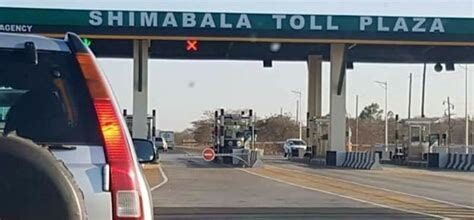Zambia has an extensive network of toll stations under the National Road Tolling Programme, which includes inland toll plazas, weighbridges, and border points.

Here’s a list of 40 toll stations across Zambia:
Inland Toll Plazas
- Katuba Toll Plaza (Great North Road, near Chisamba)
- Shimabala Toll Plaza (Lusaka to Kafue Road)
- Mumbwa Toll Plaza (Lusaka to Mumbwa Road)
- Kafulafuta Toll Plaza (Ndola to Kapiri Mposhi Road)
- Manyumbi Toll Plaza (Kabwe to Kapiri Mposhi Road)
- Choma Toll Plaza (Great North Road, Choma area)
- Mwami Toll Plaza (Chipata to Malawi Border Road)
- Kalense Toll Plaza (Northern Province)
- Kasama Toll Plaza (Northern Province)
- Chongwe Toll Plaza (Great East Road, Chongwe area)
Weighbridges
These weighbridges also serve as toll collection points: 11. Kafue Weighbridge 12. Kapiri Mposhi Weighbridge 13. Mpika Weighbridge 14. Kazungula Weighbridge 15. Chingola Weighbridge 16. Kasumbalesa Weighbridge (near DRC border) 17. Livingstone Weighbridge 18. Nakonde Weighbridge
Border Toll Stations
- Chirundu Border Post (Zambia-Zimbabwe border)
- Kazungula Border Post (Zambia-Botswana border)
- Nakonde Border Post (Zambia-Tanzania border)
- Mwami Border Post (Zambia-Malawi border)
- Katima Mulilo Border Post (Zambia-Namibia border)
- Sakanya Border Post (Zambia-DRC border)
Additional Toll Plazas
- Serenje Toll Plaza
- Isoka Toll Plaza
- Mbala Toll Plaza
- Chilanga Toll Plaza
- Mpongwe Toll Plaza
- Mansa Toll Plaza
- Solwezi Toll Plaza
- Mongu Toll Plaza
- Luangwa Bridge Toll Plaza
- Lufwanyama Toll Plaza
- Kasumbalesa Toll Plaza
Planned and New Toll Sites
- Ndola Toll Plaza (on Copperbelt highways)
- Kalulushi Toll Plaza
- Petauke Toll Plaza
- Lundazi Toll Plaza
- Kaputa Toll Plaza
These toll stations are critical for generating funds for maintaining Zambia's road infrastructure. Toll fees are collected based on vehicle type, and frequent local users can apply for discounts
Developmental merits of toll stations
Toll stations play a vital role in Zambia's economic and infrastructural development by providing a sustainable source of revenue for road maintenance and improvements. Here's how they contribute to development:
1. Revenue Generation for Road Maintenance
- Toll fees collected from vehicles using toll roads provide consistent funding for maintaining and upgrading road infrastructure. This reduces dependency on loans or external donors.
- The Road Development Agency (RDA) has reported significant contributions to the treasury, helping to ensure financial sustainability for road-related projects
2. Improved Road Infrastructure
- Revenue from toll stations is directly reinvested in repairing and maintaining Zambia's road network, leading to safer and more efficient transportation.
- Improved roads lower vehicle operating costs, such as fuel consumption and maintenance, benefiting businesses and citizens alike.
3. Boost to Trade and Tourism
- Efficient and well-maintained roads enhance connectivity between major cities, border points, and neighboring countries, facilitating trade.
- Improved road networks encourage tourism, especially to attractions like Victoria Falls and national parks, by providing better access
4. Job Creation
- Toll stations create direct employment opportunities for toll operators and maintenance crews.
- Indirect jobs are also created in construction, roadside services, and the broader economy through improved road networks.
5. Encourages Private Sector Investment
- Better infrastructure attracts local and foreign investment, as businesses benefit from reduced transportation costs and improved supply chain efficiency.
- Reliable road infrastructure supports sectors like agriculture and mining, crucial for Zambia's economy.
6. Promotes Regional Integration
- Toll roads connecting Zambia to regional neighbors (e.g., at Kazungula, Nakonde, and Chirundu) promote regional trade under agreements like the Southern African Development Community (SADC) and the Common Market for Eastern and Southern Africa (COMESA).
7. Environmental Benefits
- Improved roads reduce travel time and congestion, leading to lower emissions from vehicles, contributing to environmental sustainability.
Challenges and Mitigation
While toll fees can be a burden for some road users, the government has introduced discounts for frequent users and locals residing near toll stations to balance affordability and revenue generation
In summary, toll stations are a critical tool in driving Zambia's infrastructural and economic growth, fostering development in multiple sectors while ensuring the sustainability of the road network.
Toll gate fees for different vehicles
Toll fees on Zambian roads vary depending on vehicle type and the road used. As of 2024:
- Light motor vehicles: K20 per toll point.
- Mini-buses and light trucks: K30.
- Heavy goods vehicles (up to three axles): K200–K250.
- Heavy goods vehicles (four or more axles): K300–K500.
- Abnormal load vehicles: Up to K800 in some cases
These fees contribute to maintaining and upgrading Zambia's road infrastructure, supporting economic growth and smoother transportation

